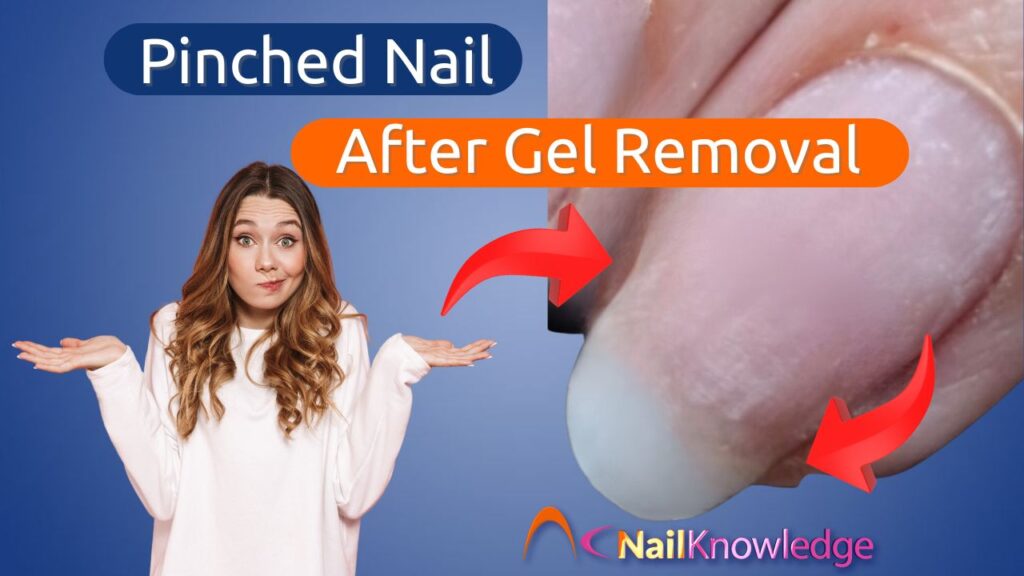If you’ve ever looked down at your nails and noticed one of them narrowing oddly at the tip, sometimes even feeling a little tight or uncomfortable, you’re not alone. A question that comes up frequently in salons and online forums is: “What is this strange shape happening to my nail?” More often than not, it’s something called a pinched nail, and it’s especially common after gel removal.
This seemingly small change can feel alarming, particularly if it’s a new development. The good news? It’s usually reversible once you understand the underlying causes — and that’s exactly what we’re unpacking today. Whether it appeared suddenly or was masked by a product like builder gel or BIAB, a pinched nail after gel removal is your nail’s way of telling you it needs a little extra care.
What Exactly Is a Pinched Nail?
A pinched nail refers to a nail plate that appears to taper unnaturally at the free edge, creating a tight, sometimes concave shape that hugs the fingertip more than usual. It can look like the nail is being squeezed from the sides, hence the term pinched. Some people describe it as a claw-like or “sucked in” appearance at the tip, while others notice discomfort or even slight pressure under the nail.
It’s not always a cause for panic, but it is a sign that your nails are trying to tell you something.
Why You Often See a Pinched Nail After Gel Removal
This might sound familiar: you soak off your gel, buff lightly, and suddenly notice your nail looks… different. Tighter. Narrower at the tip. That’s the pinched nail showing up, and it’s incredibly common right after removing gel polish or gel overlays.
Why? Because gel products, especially those with a rigid structure like builder gels or hard gels, bond closely with the nail.
Removing them involves a mix of acetone and physical filing, two things that, when paired, can wreak havoc on the nail’s natural moisture and structure. Acetone shrinks and dehydrates the nail plate, while filing thins it, especially around the edges. This combo weakens the sidewalls, and without that support, the nail can start to collapse inward, mimicking the look of a pinched nail. Even if you’ve been super careful, small bits of overfiling across several appointments can add up. And the thinner the free edge becomes, the more prone it is to curling or “pinching” once the gel is gone and the nail is left unsupported.
This is why many people notice a pinched nail only after gel is removed — not because it appeared suddenly, but because the gel had been masking the shape change all along.
How Gel Shrinkage and Hyponychium Response Can Alter Nail Shape
Behind the free edge of the nail plate lies the hyponychium, one of the important guardian seals, what you may not be aware of is a lot of BIAB’s or Builder Gels shrink when they cure, how much they shrink depends on the ingredients, but know that they all do to some extent and if you have filed into the lateral nail folds and weakened the nail plate the structure of the nail is compromised and the nail plate will change shape. The other part of the problem is due to the pressure on the free edge the hyponychium will be irritated and part of its defense when its irritated is to call in the troops and thicken a little, causing more pressure on the underside of the free edge. How do we know this? During the Covid-19 pandemic a lot of our consumers removed their own nail product as this couldn’t be infilled, so 2 things happened:
- They filled too much in an effort to remove the product
- They couldn’t get their nails redone and the hyponychium had time to recover.

Fig 3a: Slightly raised hyponychium
Fig 3b: Three months into lockdown – the hyponychium is relaxed the nail plate is not damaged by filing into the lateral nail folds or roughing up the nail plate before reapplying the Gel.
Common Causes of a Pinched Nail
Now that we’ve tackled the gel connection, let’s look at other factors that can trigger or worsen a pinched nail:
1. Overfiling the Sidewalls
Possibly the biggest offender. Over time, repeated filing — even gentle — can thin the sidewalls, especially when removing enhancements like Plexigel. Once those side areas lose structure, the nail’s free edge is left vulnerable and can start curling inwards as it grows.
2. Dehydration from Acetone Soaks
Acetone, while great for product removal, pulls moisture from both the nail plate and surrounding skin. If you’ve ever felt that chalky, tight sensation post-soak, you know the feeling. Prolonged exposure, especially if followed by buffing, can temporarily (or permanently) warp the nail shape.
3. Natural Anatomy or Repetitive Trauma
Some people are naturally more prone to a pinched nail due to their nail bed shape. But if it’s something you’ve only recently noticed, look at lifestyle habits. Typing, picking, tapping, or even frequent exposure to pressure under the free edge can distort growth over time.
4. Hyponychium Changes
The hyponychium, the sensitive skin under the free edge, can shift or recede if irritated. This may happen due to overfiling, chemical exposure, gel shrinkage during curing or friction. When this skin detaches or becomes inflamed, the nail may grow in tighter, adding to that pinched look.
How to Care for and Prevent a Pinched Nail
If you suspect you’re dealing with a pinched nail, don’t panic. It’s often reversible with a little care and patience.
1. Take a Break
Step away from enhancements and give your nails a chance to recover. A month without gels or removals will allow the nail plate to grow normally and recover its natural shape.
2. Rehydrate, Rehydrate, Rehydrate
Nails need moisture just like skin. Apply a good quality nail & skin oil behind the free edge at least 4 times a day. Rinse your hands a few times a day with an Allantoïne & Ureum rinse, this will help recondition the nail and surrounding tissue, and finish with a little of your favorite lotion, if it contains Allantoïne and Ureum that’s an added bonus and your nails and nail area will love you for it.
3. Minimise Further Trauma
During this recovery period, Keep nails trimmed short to prevent catching or bending. Be gentle when typing, opening containers, or using your nails as tools (just don’t!).
4. Avoid Filing Thin Areas
Skip the sidewalls entirely when buffing or shaping for now. Focus only on gentle surface smoothing if needed — and avoid pressure.
5. Monitor for Patterns
If it’s spreading to other nails or worsening, it could signal an underlying health or nutritional issue. Keep an eye out and consider speaking to a pro if you’re concerned.
Final Thoughts
A pinched nail might start as a subtle cosmetic change, but it’s often a message from your body or your habits, that something needs adjusting. Whether it’s overfiling, dehydration, trauma, product shrinkage or just the aftermath of gel removal, paying attention early can help you course-correct and avoid long-term damage.
The silver lining?
Nails are resilient. With a good recovery plan, care, and a few small tweaks to your routine, most pinched nails can bounce back to full strength, and beauty.


